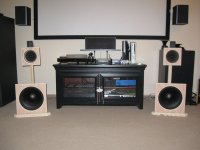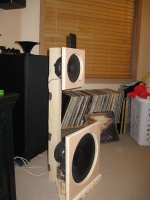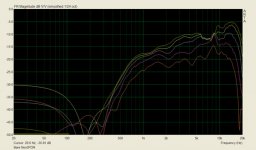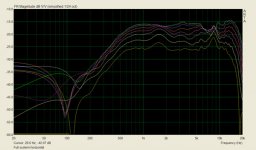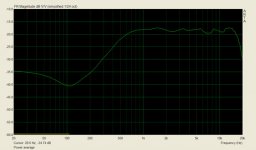I'd like to showcase my latest loudspeaker design, a dipole loudspeaker that has practically no baffle at mid and high frequencies. Drivers are two Visaton W300S woofers in a small U-frame, a Visaton AL170 for the midrange and a Bohlender&Graebener Neo3W for treble. Crossing and EQ are done with digital equipment from Behringer - the Ultra-Curve equalizer and the DCX crossover.
The crossover between bass and mid is between 300 and 350 hz. The mid to high crossover is around 1.7 khz. I've tried a lower crossoverpoint between bass en mid, but I ran out of thermal dynamic range on the AL170; not so strange, considering the approximately 11 dB of boost needed at 200 hz. A lower crossoverpoint between mid and tweeter is not practical, as the natural rolloff of the Neo3W without baffle is very steep below 1700hz.
The speaker was finished only yesterday and the crossoverdesign is at this point based on measurements done inroom. This means anechoic to not much lower than 500 hz. Below 500 hz the response is optimized for steady-state response at the main listening position. When it gets a little warmer outside (It's freezing cold now), I'll do some anechoic measurements in the garden.
My previous dipole speaker was a passive design with a large baffle, used to not let efficiency become all to low. In direct comparison to the Linkwitz Orion it became clear there was room for improvement. My dipole had constant directivity up to approx. 800 hz, whereas the Orion has constant directivity up to almost 2 khz. The Orion delivered a much more credible and specious soundstage and the sound was less tiring. (side-note: Although the Orion was one of the best speakers I had heard at that time, in my opinion the Pluto - at mid and high frequencies - sounded even better than the Orion)
The reason to use no baffle for the midrange and treble is to keep dipole-radiation to as high a frequency as possible. By maintaining dipole radiation, dispersion remains well-controlled. Simulations in Tolvan Edge showed that using a very small baffle would be the optimum with respect to directivity-control. The midwoofer has its first dipole-bump (where sound radiated at the front and the rear add up in phase) at 1.5 khz. Below this frequency the response starts to roll off with 6 dB/oct. This means this speaker is very inefficient. That is the price to pay for a pure dipole radiation-pattern. The peak is very symmetrical and can thus be easily equalized.
Initially I wanted to use the B&G Neo3PDR, which has wider dispersion at higher frequencies than the Neo3W. However, this wide dispersion leads to much more severe diffraction effects in the high treble. The beaming of the Neo3W helps to keep dispersion well-controlled. The dipole-bump is centered around 3.5 khz. Below 1.7 khz it rolls of very steeply, due to both the dipole loss and the drivers' own frequency response. All in all it needs a lot less boost than the midrange.
There is not very much to say about the low end. The speaker uses two 12" woofers in a U-frame with a small depth. The quarter-wave resonance -centered around 400 hz - is not very pronounced and is easily equalized. I don't think it is audible. The response is pulled flat to 35 hz. Below this frequency a high-pass keeps the drivers from over-excursion.
Well, how does it sound? Very good (a lot better than the prototype looks, anyway)! I'm not too good at describing sound. I think the measurements speak for themselves. I've not yet compared these directly to the Orion, but I think these dipoles sound even better! At least the measurements look quite a lot better than those of the Orion. As an experiment - to keep the sound-power-average as smooth as possible - the on-axis response above 10 khz is lifted. This is not really audible to me. Note that the green curve is the averaged response.
Response from on-axis to 90 degrees off-axis + average curve.
The on-axis dip around 6.5 khz is there to compensate for diffraction-effects that are visible off-axis. I'll probably experiment a bit with dampening material at the edges of the tweeter to reduce diffraction.
With more time on tweaking the crossover between mid and tweeter I think I should be able to reduce the dip at 1.5 khz.
The crossover between bass and mid is between 300 and 350 hz. The mid to high crossover is around 1.7 khz. I've tried a lower crossoverpoint between bass en mid, but I ran out of thermal dynamic range on the AL170; not so strange, considering the approximately 11 dB of boost needed at 200 hz. A lower crossoverpoint between mid and tweeter is not practical, as the natural rolloff of the Neo3W without baffle is very steep below 1700hz.
The speaker was finished only yesterday and the crossoverdesign is at this point based on measurements done inroom. This means anechoic to not much lower than 500 hz. Below 500 hz the response is optimized for steady-state response at the main listening position. When it gets a little warmer outside (It's freezing cold now), I'll do some anechoic measurements in the garden.
My previous dipole speaker was a passive design with a large baffle, used to not let efficiency become all to low. In direct comparison to the Linkwitz Orion it became clear there was room for improvement. My dipole had constant directivity up to approx. 800 hz, whereas the Orion has constant directivity up to almost 2 khz. The Orion delivered a much more credible and specious soundstage and the sound was less tiring. (side-note: Although the Orion was one of the best speakers I had heard at that time, in my opinion the Pluto - at mid and high frequencies - sounded even better than the Orion)
The reason to use no baffle for the midrange and treble is to keep dipole-radiation to as high a frequency as possible. By maintaining dipole radiation, dispersion remains well-controlled. Simulations in Tolvan Edge showed that using a very small baffle would be the optimum with respect to directivity-control. The midwoofer has its first dipole-bump (where sound radiated at the front and the rear add up in phase) at 1.5 khz. Below this frequency the response starts to roll off with 6 dB/oct. This means this speaker is very inefficient. That is the price to pay for a pure dipole radiation-pattern. The peak is very symmetrical and can thus be easily equalized.
An externally hosted image should be here but it was not working when we last tested it.
An externally hosted image should be here but it was not working when we last tested it.
Initially I wanted to use the B&G Neo3PDR, which has wider dispersion at higher frequencies than the Neo3W. However, this wide dispersion leads to much more severe diffraction effects in the high treble. The beaming of the Neo3W helps to keep dispersion well-controlled. The dipole-bump is centered around 3.5 khz. Below 1.7 khz it rolls of very steeply, due to both the dipole loss and the drivers' own frequency response. All in all it needs a lot less boost than the midrange.
There is not very much to say about the low end. The speaker uses two 12" woofers in a U-frame with a small depth. The quarter-wave resonance -centered around 400 hz - is not very pronounced and is easily equalized. I don't think it is audible. The response is pulled flat to 35 hz. Below this frequency a high-pass keeps the drivers from over-excursion.
An externally hosted image should be here but it was not working when we last tested it.
Well, how does it sound? Very good (a lot better than the prototype looks, anyway)! I'm not too good at describing sound. I think the measurements speak for themselves. I've not yet compared these directly to the Orion, but I think these dipoles sound even better! At least the measurements look quite a lot better than those of the Orion. As an experiment - to keep the sound-power-average as smooth as possible - the on-axis response above 10 khz is lifted. This is not really audible to me. Note that the green curve is the averaged response.
An externally hosted image should be here but it was not working when we last tested it.
Response from on-axis to 90 degrees off-axis + average curve.
The on-axis dip around 6.5 khz is there to compensate for diffraction-effects that are visible off-axis. I'll probably experiment a bit with dampening material at the edges of the tweeter to reduce diffraction.
With more time on tweaking the crossover between mid and tweeter I think I should be able to reduce the dip at 1.5 khz.
Funny,
just in the coldest part of winter some guys can't refrain from stripping their dipoles to bare nakedness.
Saurav's design
StigErik & Valentino
While I don't want to distract you from relishing those lovely curvatures and slim waists - just a question:
How do you think about setting the Neo back to the acoustic center of the AL 150 to achieve a better forward-backward symmetry? At 1.7 kHz even 5 cm fore or back can make a measurable (if not audible) difference.
Generally I like what I see in the measurement graphs. The pictures - well, it looks more like Picasso than Rubens. But who am I to complain?
Rudolf
just in the coldest part of winter some guys can't refrain from stripping their dipoles to bare nakedness.
Saurav's design
StigErik & Valentino
While I don't want to distract you from relishing those lovely curvatures and slim waists - just a question:
How do you think about setting the Neo back to the acoustic center of the AL 150 to achieve a better forward-backward symmetry? At 1.7 kHz even 5 cm fore or back can make a measurable (if not audible) difference.
Generally I like what I see in the measurement graphs. The pictures - well, it looks more like Picasso than Rubens. But who am I to complain?
Rudolf
How do you think about setting the Neo back to the acoustic center of the AL 150 to achieve a better forward-backward symmetry? At 1.7 kHz even 5 cm fore or back can make a measurable (if not audible) difference.
Hi Rudolf,
I'll have a look at those other projects. Good to see more people moving towards a similar concept! I think it is the next logical step in de evolution of dipole loudspeakers.
The mounting of the tweeter was done this way mainly for mounting convenience. You have point, though. I think I'll experiment with it. However, I fear it will lead to both diffraction (from tweeter against the mid's basket), as well as even more awkward looks
Do you have other suggestions or remarks?
Martijn
Congatulations! Very nice project, I bet it sounds very good. 
Interesting that you see diffraction problems with the tweeter. I had huge problems with the big Beyma TPL-150 I used, but the smaller Mundorf AMT2340 was almost perfect in this respect.
Do you mind publishing your XO and EQ settings ?
Interesting that you see diffraction problems with the tweeter. I had huge problems with the big Beyma TPL-150 I used, but the smaller Mundorf AMT2340 was almost perfect in this respect.
Do you mind publishing your XO and EQ settings ?
What do you think would be the best compromise?
Do you have other suggestions or remarks?
Hi Martijn,
probably there is no easy answer to where the best compromise would be. Movement of the Neo3 along the z-axis will only affect the crossover region. Maybe it can help in reducing the beaming tendency around 1.5 kHz.
I just get curious when people mount drivers at 'obvious' positions which don't automatically need to be 'best' positions.
Keeping in mind that your unbaffled dipole already has passed the Orion as your personal reference, my proposal surely could only be good for a very small improvement - if at all.
Congatulations! Very nice project, I bet it sounds very good.
Interesting that you see diffraction problems with the tweeter. I had huge problems with the big Beyma TPL-150 I used, but the smaller Mundorf AMT2340 was almost perfect in this respect.
Do you mind publishing your XO and EQ settings ?
Thanks!
The diffraction I measure didn't show up in the simulations. I'm not sure as to what exacly causes it.
I've been working my way through your topic btw. It's a great resource! However, I haven't seen many measurement plots (which I like so very much
I sure don't mind publishing the settings. Yet I think I'd better wait until I've further optimized things. Furthermore, is there an easy way of publishing the settings? I mean, I don't have to make a list of every single correction, do I?
It's just that I have both devices and with the Ultra-Curve it is a little easier to do EQ. This way I don't continuously have to make my way through the menu of the DCX to switch between crossover settings and EQ  .
.
Something else: I think I shouldn't have insisted on doing the crossover between mid and tweeter as low as possible. The AL170 actually has excellent polar response up to 2 khz, with only about -10dB at 2 khz vs. the -6dB theoretical ideal. The Neo3W falls off rapidly below 2 khz. It's difficult to get them properly phase-aligned through the crossover region. Crossing around 2 khz is probably a better idea. That'll have to wait till Friday, though.
Something else: I think I shouldn't have insisted on doing the crossover between mid and tweeter as low as possible. The AL170 actually has excellent polar response up to 2 khz, with only about -10dB at 2 khz vs. the -6dB theoretical ideal. The Neo3W falls off rapidly below 2 khz. It's difficult to get them properly phase-aligned through the crossover region. Crossing around 2 khz is probably a better idea. That'll have to wait till Friday, though.
I recommend using the PC remote software for the DCX, far easier to work with, and you can do screenshots to show us EQ graphs... 
Also - I think its better to EQ each driver individually than to use global EQ after XO. You can't do that if you do EQ with the DEQ and XO with the DCX.
Your're right - I should present measurements of my own dipoles. Will look into that. Problem is that its more fun to listen to music than do measurements all the time...
Also - I think its better to EQ each driver individually than to use global EQ after XO. You can't do that if you do EQ with the DEQ and XO with the DCX.
Your're right - I should present measurements of my own dipoles. Will look into that. Problem is that its more fun to listen to music than do measurements all the time...
At the moment I'm using a combination of EQ on individual drivers and global EQ. I have done this all manually, but doing it from the computer seems a much easier way.
Tuning mainly by ear can lead to good results, but the combination of listening and measurements gets you there a lot quicker!
Tuning mainly by ear can lead to good results, but the combination of listening and measurements gets you there a lot quicker!
Ok, you seem to be knowing what you're doing here! I usually do a combination of individual and global EQ as well. I dial it all flat and nice by measurement, and then adjust the global EQ to taste, mainly by listening. Sometimes I assist with measurements just to check if I'm not too far off, or if there's something wrong I dont quite catch only by adjusting EQ based on listening.
It's interesting to see these designs that are somewhat similar in concept  Here's what mine currently looks like:
Here's what mine currently looks like:
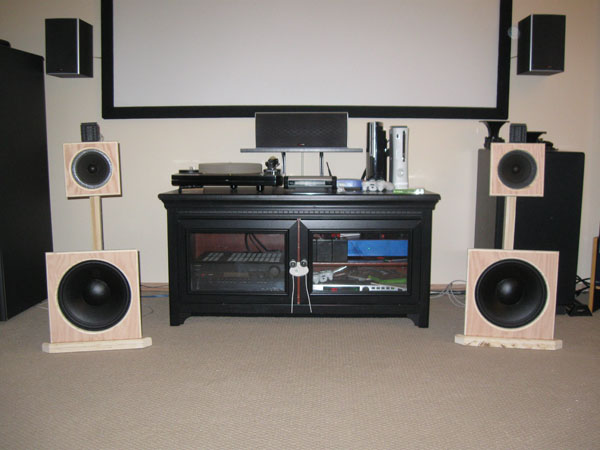
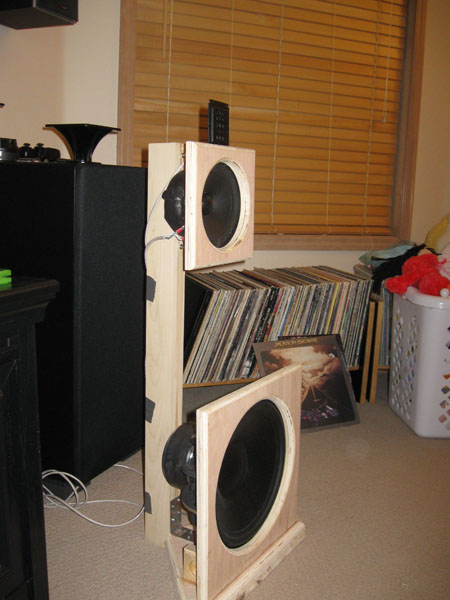
I don't have saved measurements of the full system yet, and I'm still playing with the crossover. Drivers are B&G Neo3PDRW, Audax PR170M0, AE OB12, crossover is a DCX. The bare PDR has a diffraction null around 7kHz that I need to try and address with foam, and I also need to think about how to move the tweeter back to better align it with the midrange acoustic center.
I don't have saved measurements of the full system yet, and I'm still playing with the crossover. Drivers are B&G Neo3PDRW, Audax PR170M0, AE OB12, crossover is a DCX. The bare PDR has a diffraction null around 7kHz that I need to try and address with foam, and I also need to think about how to move the tweeter back to better align it with the midrange acoustic center.
Attachments
Actually, I have some measurements I can share:
'Nude' Neo3PDRW:
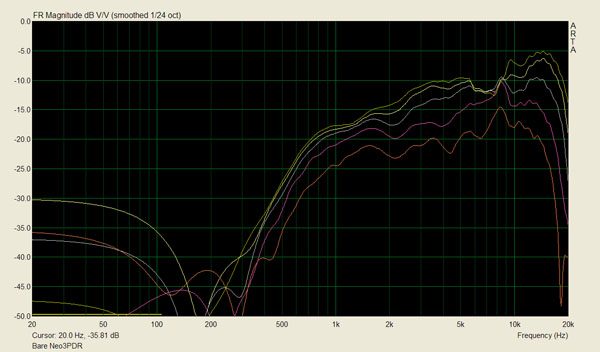
The full system polars from an earlier version. The bass drops off due to the gating. I didn't try to boost the 7kHz null, since that'll make the off-axis worse. I'll play with foam / felt and see what I can do. I think I ended up dropping the tweeter level 1-2dB after listening to this for a while.
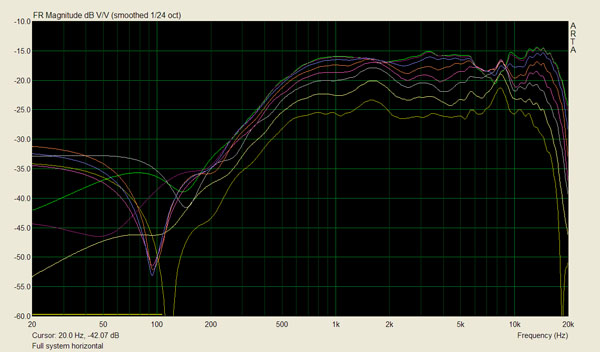
And the power average of the previous measurements:
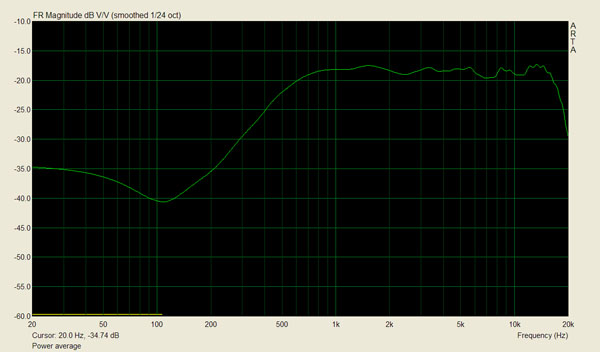
'Nude' Neo3PDRW:
The full system polars from an earlier version. The bass drops off due to the gating. I didn't try to boost the 7kHz null, since that'll make the off-axis worse. I'll play with foam / felt and see what I can do. I think I ended up dropping the tweeter level 1-2dB after listening to this for a while.
And the power average of the previous measurements:
Attachments
Saurav,
Looking good! Your plots show a small off-axis bump between 1 and 2 khz. The tweeter seems to be at blame. All in all you've been able to maintain CD from midrange to tweeter very well, though! Counting the number of curves in each plot I haven't been able to make sure which curve represents which angle. Would you please clarify?
Saturday I'll probably be in the opportunity to compare the Neo3W to the Neo3PDR. The Neo3W was chosen for this project because simulations indicated there would be less diffraction at high frequencies due to beaming of the tweeter. I reckoned I'd sacrifice top-octave response for smoother dispersion below 10 khz. In your plots the diffraction starting around 6 khz looks not much worse than the diffraction I'm measuring with the Neo3W. It's probably worth to investigate.
Looking good! Your plots show a small off-axis bump between 1 and 2 khz. The tweeter seems to be at blame. All in all you've been able to maintain CD from midrange to tweeter very well, though! Counting the number of curves in each plot I haven't been able to make sure which curve represents which angle. Would you please clarify?
Saturday I'll probably be in the opportunity to compare the Neo3W to the Neo3PDR. The Neo3W was chosen for this project because simulations indicated there would be less diffraction at high frequencies due to beaming of the tweeter. I reckoned I'd sacrifice top-octave response for smoother dispersion below 10 khz. In your plots the diffraction starting around 6 khz looks not much worse than the diffraction I'm measuring with the Neo3W. It's probably worth to investigate.
I can understand the 'hate'-part when it comes to tot back-to-back dome tweeters, but I honestly don't understand why so many people still persist in using dual domes. Going that route was never seriously considered for my project, as there are too many complications without any apparent advantage over a dipole tweeter. Especially when a wonderful tweeter such as the Neo's can be had for only $40.
By the way, if there are more people now finding unbaffled dipoles to be the next step in the dipole evolution, why are people like Siegfried Linkwitz and John Kreskovsky not picking up the concept?
By the way, if there are more people now finding unbaffled dipoles to be the next step in the dipole evolution, why are people like Siegfried Linkwitz and John Kreskovsky not picking up the concept?
I agree that unbaffled dipoles is the "next step" compared to the traditional wide baffles, but an other step from unbaffled is to fully suspend the drivers. The means no small baffles, no mouting brackets, just hang the drivers in wire. Believe me - there is a lot to gain in sound quality by suspending the drivers this way.
- Status
- This old topic is closed. If you want to reopen this topic, contact a moderator using the "Report Post" button.
- Home
- Loudspeakers
- Multi-Way
- Unbaffled Dipole
